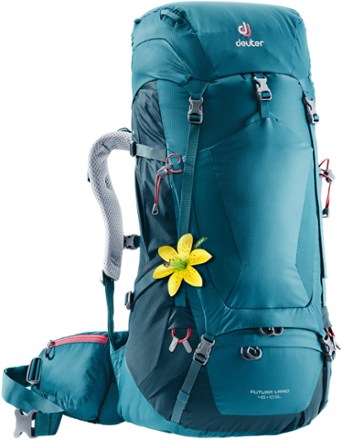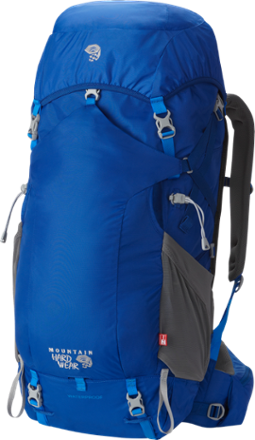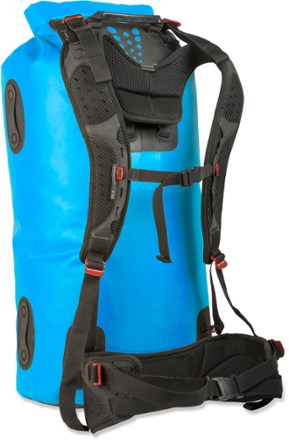
Best Waterproof Backpacks
For Hikers:
How To Find Them
By Diane Spicer
Waterproof backpacks are a nice idea in theory.
- Sorta like unicorns.
But can you get your hands on one?
Excellent question, dear hiker.
Let's find out.
Waterproof backpacks -
who needs them?
Hikers live in fear of getting wet if the temperature is below what you would consider a balmy, mild summer day.
Why?
Lots of reasons:
- The risk of hypothermia
- Chafed, chapped skin from damp clothing or wet gear
- The misery of a wet sleeping bag
- Damage to expensive hiking equipment or electronics
- Having to air dry all of the contents of a backpack, after doing a little dance to entice the sun to shine
...to name just a few.
So evading water drops is not just a unicorn quest, it's a necessity on the trail.
FYI
No unicorns will be hunted in order to answer these questions.
Hiking For Her hearts unicorns
But is a fully waterproof
backpack a reality?
To be fully waterproof is a tall order for a day pack or backpacking pack.
- Read this to parse the differences between water proof, repellent, and resistant.
- Waterproof material is what we're going for, not a water resistant backpack.
Answer one question
So here's the pivotal question to ask yourself as a hiker:
Do you really need a fully waterproof pack?
Answer yes, if you:
- want to protect expensive equipment from water;
- expect to hike through lots of river crossings and want dry gear at the end of the day;
- plan to rack up some mileage in notoriously wet conditions like parts of Alaska, the Pacific Northwest, or elsewhere on the planet that dumps rain during certain seasons;
- are going to switch between water travel and backpacking, as in the fine sport of packrafting.
Maybe waterproof isn't
necessary for you
You might just need a waterproof rain cover to go over your water repellent backpack.
- Be sure to re-apply the water repellency finish every season if your pack gets wet a lot.
- Do a little test at home: spray water on the cover, and the pack, and see if it beads up and rolls off. If it soaks in, you need another application.
- Whenever you wash your backpack(s), reapply once they are dry again. Don't take a chance out in the field with gear that might soak up water like a sponge.
More options
Or buy a dry bag to make sure your camera or sleeping bag stays dry.
- I use big ones like this, and smaller ones like this.
- Very versatile, practically indestructible, and perform well in temperature extremes.
You could use a large heavy duty plastic garbage bag over your pack for a day hike. (Not recommended, by the way, unless you also have duct tape to repair the inevitable rips and holes.)
Weigh the risks and costs
Everything depends upon the level of risk of getting wet you want to assume, and the amount of money you are willing to invest in a pack that can stand up to the demands of your hiking trip(s).
I have both kinds of backpacks:
|
water repellent day and backpacking packs with fitted waterproof covers that attach via straps and elastic, like this one from Deuter: |

|
... and ...

|
fully waterproof backpacks like this Mountain Hardwear Ozonic 50 OutDry Pack, with dry bags inside (I'm an over-planner, what can I say?) for river/hike combo trips. |
When I'm way out in the sticks (Greenland, Alaska, Northwest Territories), I make sure I'm as protected from moisture as possible.
- There is very little margin for error out there, and the risks associated with getting wet are higher than on the AT or PCT in August.
So pick your poison!
Personally, I'd rather skimp on the shirt I'm wearing, and pay
more for a backpack that will stand up to whatever Mother Nature throws
at me.
- Soggy sleeping bag after a hard day of hiking, yuck!!
- Double rainbows enjoyed in dry socks from the comfort of my dry tent, hurrah!

Waterproof backpacks -
what they offer
The features of the best waterproof pack might include:
- waterproof material to exclude water completely, usually polyurethane or polyester with double-sided TPU laminate (a chemist's dream);
- variable capacity, in liters (that's a good thing; why carry a bigger pack than needed?);
- cylindrical shape and no options for loading other than the roll top closure;
- heavy, at least 2+ pounds and usually 3+ pounds;
- no external mesh pockets for water bottles, with zippered front pockets for other gear instead;
- chest strap and harness not as adjustable for a custom fit, so may pull more on your shoulders and back under a heavy load;
- padded shoulder straps to absorb impact so you can comfortably wear it;
- won't stand up to lots and lots of water, or a complete submersion, forever;
- are vulnerable to sharp edges - do your best to avoid contact with these, but always carry duct tape or other sealant methods.
Recommendation

Here's one similar to the one I use (I bought mine several years ago, so this is as close to mine as I could find): Sea to Summit 65L Hydraulic Pack.
Note:
This pack is not built for extended periods of hiking, but it can be used to haul gear that stays dry during a portage, when bushwacking to a campsite, or other wet outdoor activity.
That's how I used it, and I know it works well.
Just keep it away from sharp rocks or unsheathed blades... you know why!
Waterproof backpacks -
the reality
Not every hiker should chase the holy grail
of waterproof packs.
They are expensive, can be heavy, and most don't fit well enough to be used for lots of mileage.
However, they are absolutely necessary when you are up against wet conditions or will be mixing extensive water travel with hiking.
Dry bags inside your water repellent backpack are a great solution to keeping certain items of technology (GPS, camera, phone, stove) safe and dry inside your water repellent pack.
- They also protect vital gear that keep you warm and dry: tent, sleeping bag, clothing.
- Choose the size (liters) that make sense for your gear.
Please don't skimp on keeping your gear dry, unless you really have no other options.
Getting wet outdoors is risky even in warm weather, and because we live in such a technology-heavy world there's no reason to take chances with hypothermia.
A happy hiker is a warm dry hiker. Repeat after me after you put on one of the best waterproof backpacks you can find...
Now read these tips on how to be a happy backpacker!
Home page > Best Hiking Gear >
Best Waterproof Backpacks
Some of the links on this page and elsewhere on Hiking For Her allow you to purchase the best hiking gear without paying extra for a small amount of your purchase price to flow to HFH.
Much appreciated!
|
I get emails all the time about what I wear, eat, carry and love to use on the trail. That's
why I provide affiliate links to you: the best gear that I use myself and have seen used by other hikers is instantly
available for your consideration, and the gear company sends a few
pennies per dollar to this reader-supported hiking website. There is no added cost to you! Everyone ends up a winner: Great gear for you, strong gear companies, and more free hiking tips for everyone. Thanks very much for your support. It's warmly and sincerely appreciated. It also helps send these hiking tips to all your virtual trail buddies around the globe. |
 |


